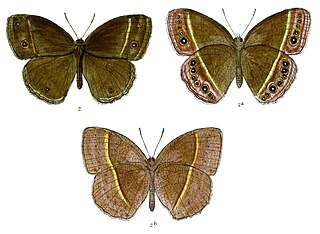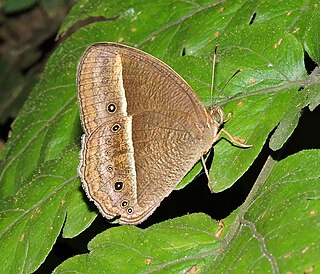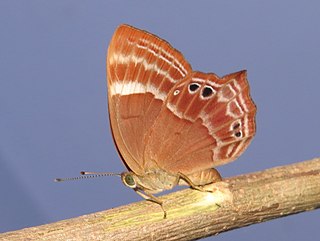
Mycalesis oculus, the red-disc bushbrown, is a satyrine butterfly found in southern India. It is similar in markings to Mycalesis adolphei but distinguished by the reddish band around the large apical spots on the upper forewings.

Mycalesis anaxias, the white-bar bushbrown, is a species of satyrid butterfly found in South and Southeast Asia. In South Asia, it inhabits Sikkim, eastwards through the hill-ranges to Assam, Cachar, Myanmar and Tenasserim. Also in southern India, in the Nilgiris and Travancore.

Papilio buddha, the Malabar banded peacock, is a species of swallowtail butterfly found in the Western Ghats of India. The Government of Kerala declared it as the official Kerala state butterfly.

Papilio clytia, the common mime, is a swallowtail butterfly found in south and southeast Asia. The butterfly belongs to the subgenus Chilasa, the black-bodied swallowtails. It serves as an excellent example of a Batesian mimic among the Indian butterflies.

Mycalesis perseus, the dingy bushbrown or common bushbrown, is a species of satyrine butterfly found in south Asia and southeast Asia.

Tanaecia lepidea, the grey count, is a species of nymphalid butterfly found in South and Southeast Asia.

Mycalesis mineus, the dark-brand bush brown, is a species of satyrine butterfly found in Asia.

Mycalesis perseoides, the Pachmarhi bushbrown, is a species of satyrine butterfly found in Asia

Mycalesis subdita, the Tamil bushbrown, is a satyrine butterfly found in south India and Sri Lanka. It is not resolved whether this is a good species or is a subspecies of Mycalesis visala.

Mycalesis visala, the long-brand bushbrown, is a species of satyrine butterfly found in south Asia. It might include the Tamil bushbrown as a subspecies.

Mycalesis mestra, the white-edged bushbrown, is a species of satyrine butterfly found in Asia

Mycalesis (annamitica) lepcha, the Lepcha bushbrown, is a satyrine butterfly found in Asia. It is not resolved whether it is best considered a distinct species, or included in Mycalesis annamitica. It was formerly included in Mycalesis malsara.

Mycalesis nicotia, the brighteye bushbrown, is a species of satyrine butterfly found in Asia.

Cethosia nietneri, the Tamil lacewing, is a species of nymphalid butterfly found in Sri Lanka and south India. The species name is after John Nietner who obtained specimens of the butterfly from Ceylon from which it was described.

Lethe europa, the bamboo treebrown, is a species of Satyrinae butterfly found in Asia.

Ypthima baldus, the common five-ring, is a species of Satyrinae butterfly found in Asia.

Vindula erota, the common cruiser, is a species of nymphalid butterfly found in forested areas of tropical South Asia and Southeast Asia.

The Indian fritillary is a species of butterfly of the nymphalid or brush-footed family. It is usually found from south and southeast Asia to Australia.

Abisara bifasciata, the double-banded Judy or twospot plum Judy, is a butterfly in the family Riodinidae. It is found in Asia.

Ypthima striata, the Nilgiri jewel fourring or striated fivering, is a species of Satyrinae butterfly found in south India.


































